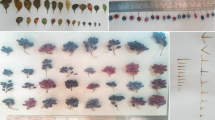Abstract
Blueberry fruits are known for their high vitamin C, essential dietary fibre, antioxidant activity and anthocyanin pigments. Different blueberry varieties have been introduced in India but no attempt has been made for their nutritional profiling. Nutritional profiling of varieties helps us to know the unique varietal characters, which serves as a guideline for recommendation of a valuable variety for fresh consumption and/or processing. Therefore, the present study was conducted in eight different blueberry varieties such as ‘Misty’, ‘Sharp Blue’, ‘Biloxi’, ‘Jewel’, ‘Gulf Coast’, ‘Blue Crop’, ‘Star’, ‘Legacy’. The results of the study revealed that all tested varieties differed significantly in physical attributes (10-berry weight, fruit firmness, roundness index, moisture content) and biochemical and functional attributes (ascorbic acid, total anthocyanin, total phenolic content, antioxidant activity, total sugars, organic acids) and mineral content. Regression analysis and Principal Component Analysis showed that antioxidant potential of blueberries was mainly contributed by phenolics followed by anthocyanins and ascorbic acid content. However for taste perception, fructose among sugars and succinic acid among sugars were the most influencing factors (p ≤ 0.05). Total phenolics and anthocyanins content were responsible for overall difference in functional attributes among the varieties. The attributes such as high fruit firmness, sensorial score, and appropriate shape and weight make ‘Misty’, the best variety for marketability and fresh consumption among all tested varieties.


Similar content being viewed by others
Abbreviations
- RI:
-
Roundness index
- AOX activity:
-
Antioxidant activity
- GAE:
-
Gallic acid equivalents
- TE:
-
Trolox equivalent
- N:
-
Newton
References
Amerine MA, Pangborn RM, Roessler EB (1965) Principles of sensory evaluation of food, 1st edn. Academic Press, New York
Apak R, Guclu K, Ozyurek M, Karademir SE (2004) Novel total antioxidants capacity index for dietary polyphenol and vitamins C and E using their cupric ion reducing capability in the presence of neocuprine: CUPRAC method. J Agric Food Chem 52:7970–7981
Avram AM, Morin P, Brownmiller C, Howard LR, Sengupta A, Wickramasinghe SR (2017) Concentrations of polyphenols from blueberry pomace extract using nanofiltration. Food Bioprod Process 106:91–101
Drozdz P, Seziene V, Pyrzynska K (2018) Mineral composition of wild and cultivated blueberries. Biol Trace Elem Res 181:173–177
Ellong EN, Adenet S, Rochefort K (2015) Physicochemical, nutritional, organoleptic characteristics and food applications of four mango (Mangifera indica) varieties. Food Nutr Sci 6:242–253
Fazli AF, Fazli NA (2014) Evaluation and determination of mineral contents in fruits. Int J Plant Environ Sci 4(2):160–166
Gil MI, Tomas F, Betty BA, Pierce H, Kader AA (2002) Antioxidant capacities, phenolic compounds, carotenoids, and vitamin C contents of nectarine, peach, and plum cultivars from California. J Agric Food Chem 50:4976–4982
Gunduz K, Serce S, Hancock JH (2015) Variation among highbush and rabbiteye cultivars of blueberry for fruit quality and phytochemical characteristics. J Food Compos Anal 38:69–79
Kumar P, Sethi S, Sharma RR, Singh S, Saha S, Sharma VK, Verma MK, Sharma SK (2018) Nutritional characterization of apple as a function of genotype. J Food Sci Technol 7:2729–2738
Lia D, Lia B, Mab Y, Suna X, Lina Y, Menga X (2017) Polyphenols, anthocyanins, and flavonoids contents and the antioxidant capacity of various cultivars of highbush and half-high blueberries. J Food Compos Anal 62:84–93
Mannozzi C, Cecchini JP, Tylewicz U, Siroli L, Patrignani F, Lanciotti R, Rocculi P, Dalla Rosa M, Romani S (2017) Study on the efficacy of edible coatings on quality of blueberry fruits during shelf-life. LWT-Food Sci Technol 85:440–444
Matiacevich S, Cofre DC, Silva P, Enrione J, Osorio F (2013) Quality parameters of six cultivars of blueberry using computer vision. Int J Food Sci 2013:1–8
Panse VG, Sukhatme PV (1984) Statistical methods for agricultural workers, 3rd edn. Indian Council of Agricultural Research, New Delhi
Ranganna S (1999) Handbook of analysis and quality control for fruits and vegetable products, 3rd edn. Tata McGraw-Hill Publishing Company Ltd, New Delhi
Reig G, Iglesias I, Gatius F, Algere S (2013) Antioxidant capacity, quality, anthochyanins and nutrients content of several peach cultivars [Prunus persica (L.) Batsch] grown in Spain. J Agric Food Chem 61(26):6344–6357
Saftner R, Polashock J, Ehlenfeldt M, Vinyard B (2008) Instrumental and sensory quality characteristics of blueberry fruit from twelve cultivars. Postharvest Biol Technol 49:19–26
Sharma RR, Krishna H (2018) A textbook of temperate fruits. CBS Publishers, New Delhi
Sharma RR, Jhalegar MJ, Jha SK, Rana V (2014) Genotypic variation in total phenolics, antioxidant activity, enzymatic activity and quality attributes among kiwifruit cultivars. J Plant Biochem Biotechnol 24:114–119
Singleton VL, Rossi JA (1965) Colorimetry of total phenolics with phosphomolybdic-phosphotungstic acid reagents. Am J Enol Vitic 16:144–158
Vaio CD, Marallo N, Graziani G, Ritieni A, Matteio AD (2014) Evaluation of fruit quality, bioactive compounds of flat peach cultivars. J Sci Food Agric 95(10):2124–2131
Wrolstad RE, Durst RW, Lee J (2005) Tracking color and pigment changes in anthocyanin products. Trends Food Sci Technol 16:423–428
Wu J, Ga RZL, Lia X, Chan F, Wang Z, Xiasng H (2007) Chemical compositional characterization of some apple cultivars. Food Chem 103:88–93
Yaman O, Bayoundurlc L (2002) Effect of an edible coating and cold storage on shelf life and quality of cherries. LWT Food Sci Technol 35:146–150
Zeppa G, Conterno L, Gerbi V (2001) Determination of organic acids, sugars, diacetyl and acetoin in cheese by high-performance liquid chromatography. J Agric Food Chem 49(6):2722–2726
Author information
Authors and Affiliations
Corresponding author
Additional information
Publisher's Note
Springer Nature remains neutral with regard to jurisdictional claims in published maps and institutional affiliations.
Rights and permissions
About this article
Cite this article
Totad, M.G., Sharma, R.R., Sethi, S. et al. Genotypic variability in nutritional and functional attributes of blueberry varieties grown in northern-western Himalayas. J Food Sci Technol 57, 2251–2258 (2020). https://doi.org/10.1007/s13197-020-04261-4
Revised:
Accepted:
Published:
Issue Date:
DOI: https://doi.org/10.1007/s13197-020-04261-4



